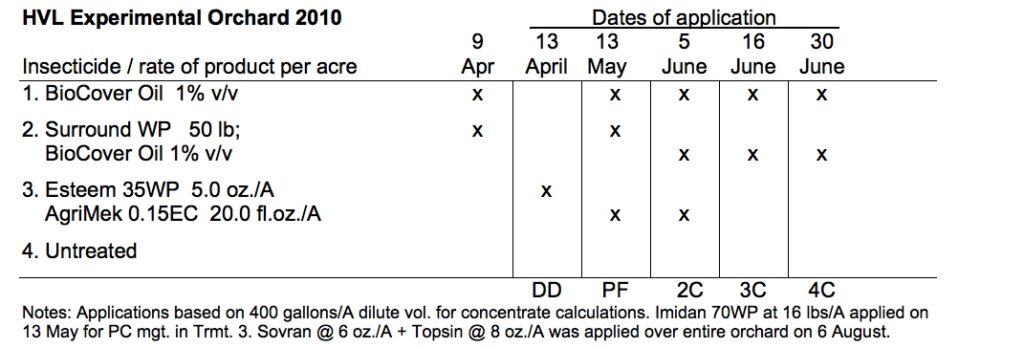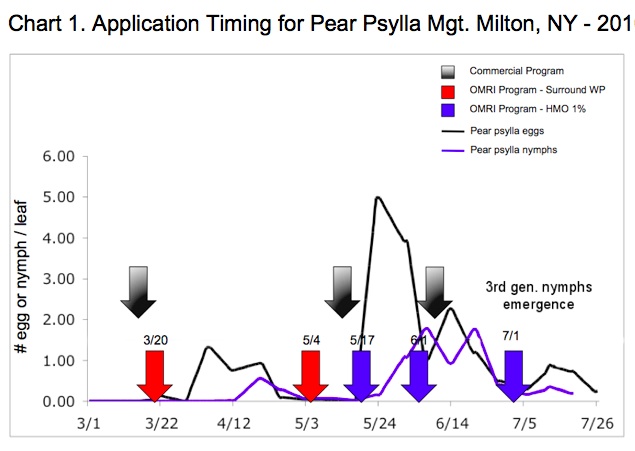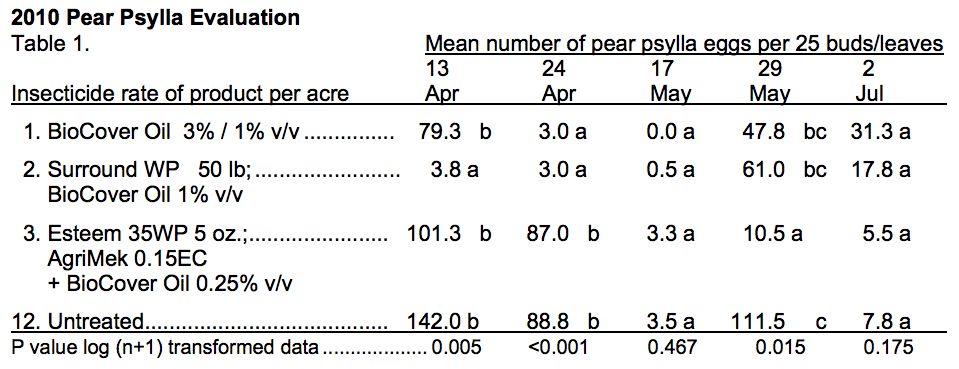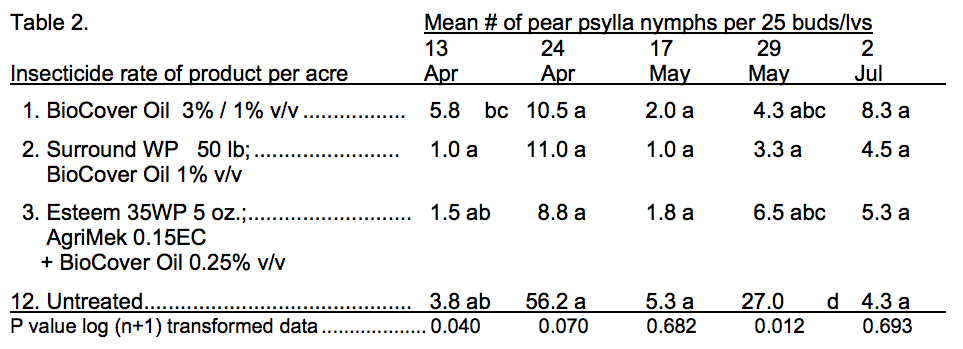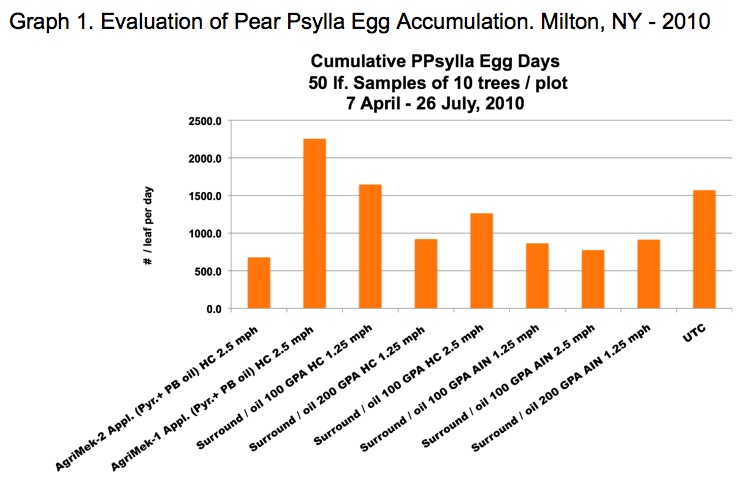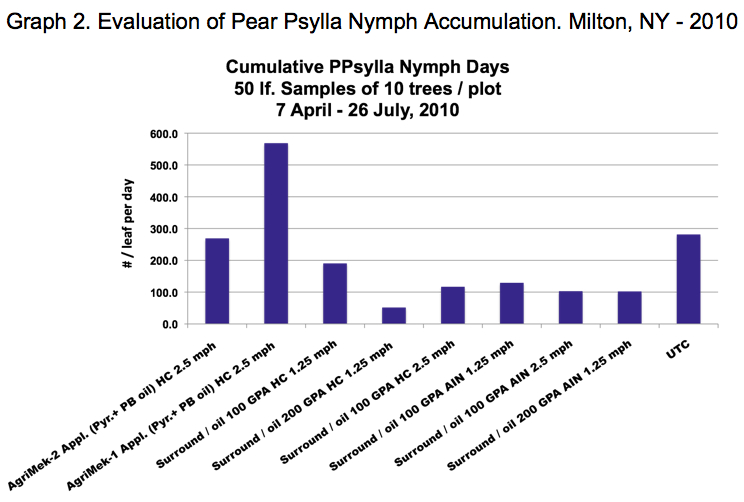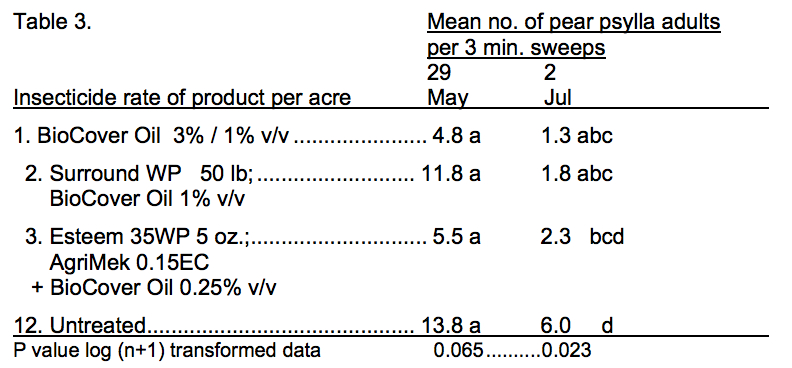2010 Annual Report for ONE10-118
Determining the Potential for Organic Material Use in Northeast Commercial Pear Production
Summary
Pear production in NYS is managed on nearly 2000 acres, with yearly crop yields producing roughly 16,500 tons valued at 3.85 million dollars. In the Hudson Valley region, pears comprise about 800 acres (USDA, 2005). The principle pests of pear production in the Northeastern US are pear psylla (Image 1), Cacopsylla pyricola (Foerster), and Fabraea leaf spot (Image 2), Fabraea maculata. These two pests cause premature defoliation, reduced size, quality and yield of fruit, followed by premature decline and eventual death of susceptible pear varieties (Images 3 & 4).
Insecticide resistance has resulted in lower levels of pear psylla insecticide susceptibility, reducing effectiveness of current pest management strategies. Recent studies conducted at Cornell University’s Hudson Valley Laboratory have demonstrated excellent control of the pear psylla using two unique OMRI products. The kaolin clay product Surround WP (anhydrous aluminum silicate) and highly refined horticultural oils (HRO’s) were used successfully in pre-bloom and season long insect management programs to maintain psylla populations below economic thresholds. Furthermore, we observed applications of HRO’s suppressing Fabraea leaf spotting and subsequent reduction in defoliation of HRO treated pear trees compared to untreated trees. Seasonal use of HRO’s for Northeast pear management beyond the pre-bloom stage has yet to be adopted in commercial orchards. This study, conducted in a commercial Hudson Valley pear orchard in Milton, NY demonstrated the commercial use of these two OMRI products as pest management tools for pear psylla management to achieve commercial levels of control.
Additional variables of air induction nozzles compared to commercial hollow disk nozzles in airblast applications to study the effects of off target drift; sprayer speed and volume were employed across field plot treatments. The need for season long management of Fabraea using applications of fungicides at ten day to two-week intervals reduce the additional application costs of bi-weekly HMO applications for post bloom pear psylla management through the incorporation of hMO’s to the fungicide program.
Objectives/Performance Targets
To determine the efficacy of OMRI materials on populations of pear psylla throughout the season by conducting comparative commercial orchard and controlled field plot studies in 2010. The components of this research fall into these two study groups. The first conducted in a one-acre experimental pear orchard at Cornell University’s Hudson Valley Laboratory in Highland, NY using dilute spray systems (Video 1). The second study conducted at a commercial pear orchard of LM Clarke, in Milton, NY using conventional airblast equipment (Video 2).
Accomplishments/Milestones
Research Farm Trials: Research Farm Trials: From 2005 to 2010 controlled field plot studies were made to determine the efficacy of OMRI materials on populations of pear psylla, however only 2010 results will be reported. Trials employing four-tree plots were replicated four times in a replicated complete block design. The 2010 early season ‘Bartlett’ phenology was the earliest in recent history, beginning at swollen bud on 19 March, 1st egg on 16 March, white bud (WB) on 8 April, delayed dormant application (DD) on 9 April, King Bloom on 10 April, 1st egg appl. on 13 April, petal fall (PF) on 20 April, > 5mm on 26 April, PF application was delayed until 28 April for plum curculio, 10dp PF on 13 May, 28 dp PF on 5 June; control of 3rd generation psylla on 30 June. ‘Bartlett’ was harvested on 12 August in which we collected and evaluated 100 fruit per treatment across 4 replicates.
Early applications targeted overwintering adult and first generation of pear psylla. During the period from bud burst through 1st cover, evaluations to determine treatment effects on springform adult ovipositional deterrence, including subsequent 1st generation nymph emergence were conducted.
Pre-bloom evaluations for pear psylla egg and nymph populations using 25 buds on 5 perimeter 1st year shoots per tree beginning on 13 April.
Seasonal leaf assessments through the season beginning with 25 basal leaves of 5 shoots on 20, 27 April and 4 May and continuing for all subsequent evaluations by removing 1 distal, 1 proximal and 3 mid-shoot leaves of 5 shoots per treatment through the remainder of the season.
Sampling dates for foliar presence of psylla nymphs were 27 April, 4, 11, 27, May; 9, 18 June and 6 July. Samples were removed to the laboratory where target pests were counted using a binocular scope. Adult numbers were assessed on 6, 18, 29 May, 16 June, 17 July using 3-minute vacuum sweeps of perimeter apical shoot foliage using a handheld vacuum and screened collection bottles.
Fifty Bartlett fruit were harvested per treatment on 18 August and scored for insect damage. The transformation using the Log10 (X + 1) was applied for adult and foliar evaluations. To stabilize variance, percentage data were transformed by arcsine *(square root of x) prior to analysis. Fisher’s Protected LSD (P=<0.05) was performed on all data; untransformed data are presented in tables.
Each plot contained four trees of alternating 30 year-old ‘Bartlett’ and ‘Bosc’ cultivars, 12’ in-row x 18’ drive-row spacing, 12 ft in height. All dilutions are based on 400 gallons/acre with plot requirements ranging from 20 to 50 gallons increasing seasonally with developing canopy. Treatments were applied using a three point hitch tractor mounted high pressure ‘Pak-Tank’ sprayer using a pecan handgun operated at 300 psi delivering >350 GPA sprayed to runoff.
One of two ‘OMRI experimental plots’ employed a single 3% HMO application at first observation of egg laying followed by a single pre-bloom (green cluster – white bud) and bi-weekly post bloom applications at a 1% dilution rate in a season long program of 4 applications using 1 nymph per leaf thresholds.
This was compared to a second plot employing Surround WP at 50#/A beginning at first egg observation followed by a white bud application and a single petal fall application. Bi-weekly post bloom applications of HMO at a 1% dilution rate followed in a season long program of 5-7 applications using 1 nymph per leaf thresholds.
Commercial Farm Trials:
One ten-acre commercial orchard divided into nine blocks were used to evaluate the effectiveness of OMRI certified pest management materials compared to commercial programs for the control of pear psylla on 34 year old European pear varieties of Bartlett and Bosc.
Applications were made using a John Deere tractor mounted three-point hitch PTO powered airblast sprayer. Trees were 12’H x 10’W spaced at 22’ row spacing. Reduction of travel speed, increased volume output and use of air induction nozzles to both reduce off-target drift and increase droplet size were employed in two OMRI programs employing hollow-cone and air induction nozzles. Dry weather in 2010 did not afford for the evaluation of Fabraea leaf spot.
Blocks 1 & 2 contain a 5-acre block to which commercial insecticides are applied using hollow-cone nozzles. A single application of Asana XL 0.66EC at 19.2 fl.oz./A pre-bloom and a single or twice applied spray of AgriMek 0.15 EC using 20.0 oz./A were made to blocks 1 & 2 respectively. Blocks 3, 4 & 5, within a 1.75-acre block received applications of OMRI materials at 100 GPA / 1.25 mph, 200 GPA / 1.25 mph and 100 GPA / 2.5 mph respectively using hollow cone nozzles. Block 6, 7 & 8, within a 1.75-acre block received applications of OMRI materials at 100 GPA / 1.25 mph, 200 GPA / 1.25 mph and 100 GPA / 2.5 mph respectively using air-induction nozzles. Block 5 consisted of 5 untreated trees.
Foliar evaluations of insecticidal efficacy were conducted throughout the season in each treatment of 4 replicates throughout blocks or plots. Pear psylla oviposition was evaluated by sampling terminal cuttings containing 5 buds and the eggs deposited on buds were counted using dissecting scopes. Bi-weekly leaf samples of 25 leaves per treatment were collected and evaluated for pear psylla nymphs and eggs. Vacuum samples of adult pear psylla made using 3-minute foliage sweeps to determine adult presence. Trees in each block or plot were rated for % defoliation. Harvest fruit evaluations will be conducted on 15 August for Bartlett and 1 September for Bosc with 100 fruit per treatment sampled and rated for % injury for all fruit feeding insects, Fabraea, sooty mold, russet, and phytotoxicity.
Impacts and Contributions/Outcomes
Results of Research Farm Trials: Over a 5-year period we observed that two to three early season applications of Surround WP at 50#/A followed by 3-7 late season 1% oil applications were comparable in pear psylla management to the most effective conventional treatments in statistical evaluations of efficacy. Surround WP was found to be comparable to commercial management in controlling early season pear psylla populations while also reducing the fruit feeding of plum curculio. Beginning two weeks after the last Surround application using bi-weekly applications of a 1% concentration of HMO’s demonstrated comparable reductions of both pear psylla oviposition and subsequent nymph population, feeding damage to foliage and fruit compared to the commercial standard (Tables 1-3). HMO applications also decreased the incidence of Fabraea leaf spot on foliage and fruit (Table 4). HMO’s employed during the season to gain control of pear psylla populations appear to be most effective when applied prior to the onset of egg laying and hatch for each generation.
Results of Commercial Farm Trials: In 2010 relatively dry conditions were conducive for long residual of OMRI materials requiring fewer applications than in ‘wet years’. We observed similar results of the commercial part of this trial to that of our small plot trials. Two early season applications of Surround WP at 50#/A followed by 3 mid-late season 1% oil applications were comparable in pear psylla management to the 3 grower applied conventional treatments. Two applications of AgriMek gave the best overall ovipositional deterrence (Graph 1). The use of air induction nozzles (AIN) generally provided comparable season long egg laying reductions compared to the commercial program and better overall results than hollow-cone nozzles in the OMRI progrm. Higher gallonage rates of application using either hollow-cone or air induction provided better results than lower application rates (Graph 2).
From five years of experimental field data and first year commercial pear insect management results, we conclude that the use of these two OMRI materials provided effective control of pear psylla and can be use as synthetic insecticide replacements. The use of these materials will assist growers in reducing the use of synthetic insecticides, especially for pear psylla control, and reduce the potential for resistance of psylla to develop insecticide resistance as pear psylla are unlikely to develop resistance to HMO’s or Surround WP as they act to smother and repel only, not acting on the insect metabolic pathways through target site bonding. Additional testing needs to be completed to determine the commercial efficacy of HMO to control pear psylla in years of normal rainfall and its ability to reduce Fabraea maculata.
Video production guide of this study is available on the Hudson Valley Regional Fruit Program web site at http://hudsonvf.cce.cornell.edu/. Insect pest management guidelines will be incorporated into the organic tree fruit In’Depth workshop in March of 2011 and into the Tree Fruit Pest Management Guidelines.
Collaborators:
LM Clark Orchard
340 Milton Tpk, PO Box 73,
Milton, NY 12547
Office Phone: 8459017440
